
Haumietiketike: Uncultivated food, wild natural provision
Exploring tuakana/ teina relationships
Trish Cooper from Hira Kindergarten had often noticed that the hard work of nurturing and empowering young kindergarten learners in sustainable practice disappeared when the children left to attend the local school. This ignited questions to seek change. What if kindergarten graduates returned occasionally and held a role in teaching the younger children about different projects? How could a tuakana/teina relationship help all learners and the community?
“Our passionate, knowledgeable gardeners, cooks and composters left in a big rush when they turned five – all 17 in one term. Although many of our sustainability practices were embedded, we really felt the loss of our “experts”. But we hadn’t lost them. They were at school still engaged in their passion for the environment! How could we use them for their knowledge inspiration and energy?” – Trish Cooper, Hira Rural Kindergarten.
Trish met with Sally Jamieson, Enviroschools lead teacher at Hira School, to share perspectives and work out ways that would value the knowledge of new entrants coming from Hira Rural Kindergarten. They discussed ways of providing these young students with opportunities to continue contributing to the kindergarten, as well as strengthening knowledge and skills within the Hira School Enviroschools programme. These ideas all supported development of a seamless transition to school for the tamariki.
The kindergarten children were excited by the prospect – they wanted to share their learning with the “big kids” who had left for school, (some of whom were their brothers and sisters), and they wanted to ask them some big questions. Teachers thought this was a better idea than looking on Google.
Wetland wonders
One flagship project has been on the Nelson City Council (NCC) land adjacent to the kindergarten. A few years ago, the community was consulted about how best to manage this area. There had been on-going issues with weeds and flooding. The project started with the intention to rehabilitate a small area beside the kindergarten so that children could play in a small patch of ‘wilderness’, however this developed into a community restoration effort of a large area of the wetland.
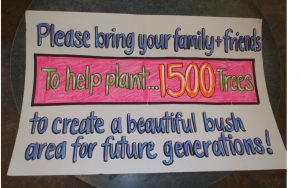
Community approach to restoration of the NCC land next to the kindergarten.
This community planting project including many local families. Part of the maintenance of this, now special, area involved inviting the juniors from Hira School to Kindergarten for the morning session to help put plant protectors around the base of the trees, to keep the weeds down. Children learnt about weeds and the trouble they can cause! (as well as the benefit of working together – mahi ngatahi!) Celebrating this work included playing together, singing songs and a barbecue lunch.
More recently, Hira School gained support from Enviroschools for a joint project with the kindergarten to work together to learn more about the local environment. The Hira School students decided that teaching the kindergarten children about the local Glenduan Wetland environment would be interesting. The school students had been involved with a previous planting programme at the wetland and wanted to learn some more about this ecosystem. They went to the Glenduan Wetland with John Campbell, an educator from the Nelson Provincial museum. He helped the students to identify some of the plants that grow well in the wetlands and talked about photosynthesis! He also shared some information about some of the birds that thrive in this wetland habitat.
Back at school the students simplified the quite complicated information and came up with the idea of preparing a treasure hunt to teach the kindergarten children about the different plants and birds that live in the wetlands. The school students and kindergarten children travelled together in the bus – a real highlight!
First there was time for a play on the playground – then it was time to get stuck into the hard work. Children worked in small groups and set off on the treasure hunt to explore the wetlands. The younger children raced off and were super excited to get a sticker every time they found something. They were all very keen bird spotters. The younger children learnt a lot about their local environment and the older ones gained a lot of skills from being in the ‘teacher’ role.
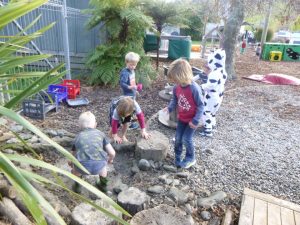
Curiosity about wetland systems showing in play.
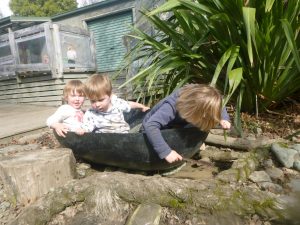
We are all in this together – modelling wetland monitoring back at kindergarten.
Tracking and trapping pests.
Hira School students have been on a pest trapping journey for over a year now and are proud to be a Kiwibank Predator Free School.

Sharing knowledge of monitoring pests.
They visited the kindergarten to share their learning and talk to the younger children about what type of pests there might be around the kindergarten. The Hira Kindergarten children asked a lot of questions! The older children helped the younger ones make tracking tunnels so that they could check what pests were about. Together they wandered around the kindergarten grounds to find the best places to put the tunnels.
“Wanted” posters were created to help identify the pests’ footprints. Later on, the kindergarten invited representatives from the school back so that they could show what was on the tracking cards and to get help with identifying the pest tracks. One of the school traps was then set to try to catch the pest.

Sharing knowledge and learning about pest footprints and monitoring cards and tunnels.
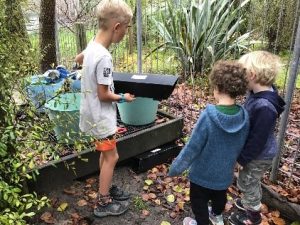
Deciding where to place the tunnel to track footprints.

Learning about baiting and setting traps.

Setting the trap.
Swapping ideas
A toy swap idea at the kindergarten arose as a result of a clothes swap event that was the great idea of Hira School student, Billie. She was so successful in her event management of the clothes swap that the kindergarten children wanted to do something similar and came up with a toy swap. The success of these two events radiated out into the community with a lot of positive comments and offers of future support.
Celebrating success
Hira Rural Kindergarten spent considerable time reflecting on their Enviroschools journey, and in August 2020, felt they were ready to share their mahi with others and collectively decide if they aligned with being a Green-Gold Enviroschool. It was an obvious aspect of this day to have representatives (Principal, lead teacher and 2 students) from Hira School at this event.
“The kindergarten children don’t ask to go on-line when they want an answer for something they are thinking about (e.g. why didn’t our monarch butterflies hatch this year?) They always want to ASK THE BIG KIDS! (that is, the students at the neighbouring school). The students investigate, then come down and talk to the younger children about what they have discovered. There is really a great transitioning between the two!” – Sandy Bell-Jameson, Enviroschools National Professional Development Coordinator, after the Green-Gold sharing and decision-making day.
Who are the experts?
When a tricky question arises in conversation during learning and play at the kindergarten the children can say – ‘Let’s ask the experts?’ and a time is organised when the school children can come and help. This has become a reciprocal arrangement and often ideas and knowledge go both ways.
“Our children still explored experimented and researched, however the increased complexity that came with our work towards reflecting for Green- Gold brought up some tricky questions. One of these was ‘What can we do about the pests?’” – Trish Cooper, Hira Rural Kindergarten
Transitioning
Because children are familiar with both environments (the places, the people, the practices, and the learning programmes) it makes for a smooth transition.
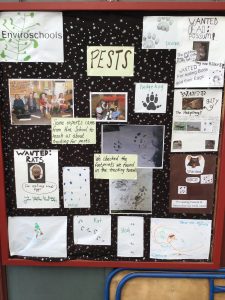
The noticeboard at the kindergarten that school students helped put together. Shifting practices to engage a community.
All the children know the staff and teachers and know about projects that are taking place. Children leaving the kindergarten for school are looking forward to contributing to the school projects and also returning to support the younger kindergarten children. The sense of belonging is strong.
All the kindergarten children visit Hira School regularly for bike riding, picnics, sports events, tours and celebrations. When children transition to school, they are already so knowledgeable about their local environment and sustainable practices and can share their understanding and ideas straight away. The school staff are familiar with the incoming children’s interests and passions before they start school. The parents don’t see the school and kindergarten as separate entities – more a learning hub.
Communication is really important and includes Enviroschools noticeboards at both places. The Hira School children helped put together the noticeboard at kindergarten about trapping and pests. Trish and Sally keep an eye on each other’s respective newsletters to find out what projects are being worked on and what events (such as Men’s breakfast and Matariki celebrations) they can participate in.
“Working with the kindergarten involves tuakana teina in action in an authentic context. It also provides opportunities for our children to be empowered students and share their understanding and knowledge. Children learn they can ask for help which is an important concept and an added complexity. This process increases self-esteem.” -Sally Jamieson, Hira School teacher
Families have been very supportive of the continuation of learning and interests. It seems parents find it more valid when the environmental learning and action focus is common across the two sites/ two groups of learners. They also see this approach is not a temporary fad. Wherever you go in the community, sustainability is deeply embedded.
Parents are more committed and engaged as well as being confident enough to share their knowledge and develop the kaupapa in their homes. This collaborative approach increases the possibilities for the whole community. Families celebrate their children’s learning and provide further opportunities (sewing, gardening, trapping in a local community). Wider community members contribute resources to school and kindergarten (e.g. material, things to swap and share, paper) as well as offering to share their own knowledge and expertise (e.g. bee keeping).
There have been some challenges along the way. Hira kindergarten is passionate about engaging in local projects but transport and child/ adult ratios working near water and ECE regulations make it almost prohibitive. The school on the other hand has had to juggle aspects like fitting visits in with timetables and ensuring relievers are available to cover for trips and PD.
Having Enviroschools PD hui together allows time to be immersed in the concepts of sustainable communities, share skills and provided another opportunity to consolidate the partnership. This really helps strengthen practice and a collaborative approach.
What have children said?
Kindergarten children are excited and ask, ‘When are the big kids coming?’, and they get the chairs ready for them. Kindergarten children divert their attention away from teachers and ask the school kids their questions directly.
“It was a fun day being part of the Green -Gold reflection and I was really proud to be part of the reflection team” – Hira School student after Hira Kindergarten Green Gold sharing and decision-making day.
Purposeful collaboration
Sally and Trish feel that this collaboration through Enviroschools projects and practices is something others should consider. They believe that being open, relaxed and starting with a social event has helped them to work well together. They are not afraid to ask each other for help, resources and ideas.
Key aspects of this include: communication, openness, celebration, having fun, learning together, realistic expectations, sharing ideas and expertise, getting as many staff on board (especially principals and administrators!).
Asked what guidance they would provide for others wanting to explore this approach Trish and Sally said to make it manageable, follow children’s interests and just go for it!
“Celebrate successes and laugh at your mistakes!” -Sally and Trish
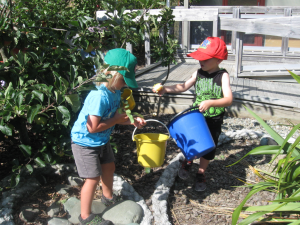
Harvesting the fruit before the pests do!
